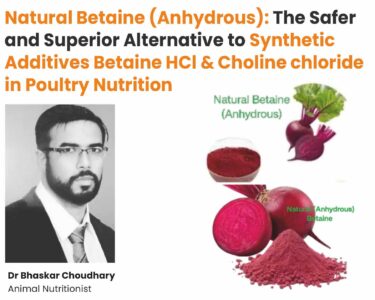CINNAMALDEHYDE-Everything the plants have that you want- LEARNING BY DOING SCIENCE…

Deep Chand Vashishtha, – M.Sc, MBA
NSM- Bioncia International Pvt Ltd
Science is a novel practise to allow potential of ingredients or elements. It will be very helpful when it meets your requirements So well said that Learning by Doing Science…Plant bioactive compounds, such as phytochemicals, in poultry diets, are gaining popularity due to their potential antioxidant and anti-microbial activities. Phytogenic feed additives (PFAs) have emerged as natural alternatives to antibiotic growth promotors and have great potential in the poultry industry. In recent years, cinnamon (one of the most widely used spices) has attracted attention from researchers as a natural product with numerous health benefits for poultry. The essential oils in cinnamon, in particular, are of interest because of their antioxidant, anti-microbial, anti-inflammatory, antifungal, and hypocholesterolaemic effects, in addition to their ability to stimulate digestive enzymes in the gut.
Know Values of Poultry Industries
India Poultry Feed Market was valued at USD 3.27 billion in 2024 and is anticipated to project impressive growth in the forecast period with a CAGR of 6.21% through 2030.17 Sept 2024The demand for poultry feed is expected to increase due to the country’s growing poultry production, the expanding retail and food service industry, and advancements in poultry breeding techniques. However, high feed costs may put downward pressure on demand.
CINNAMALDEHYDE
Cinnamon belongs to the genus Cinnamomum (Lauraceae family) which contains more than 250–300 aromatic evergreen shrubs and plant trees However, only a few of these species have significant economic importance worldwide as a common spice including Cinnamomum zeylanicum (C. zeylanicum: True Sri Lankan cinnamon), C. cassia (Chinese cinnamon), C. burmanni (Indonesian cinnamon) and C. loureiori (Vietnamese cinnamon). The annual production of cinnamon is around 0.23 million metric tons, mainly cultivated in Indonesia, Sri Lanka, China, India, Vietnam, and Madagascar.
Phytochemistry Of Cinnamaldehyde
Phytochemicals are plant bioactive non-nutritive compounds that are usually found in small quantities They have different classes according to their structure and include phenolic compounds, phytosterols, phytoestrogens, glucosinolates, saponins, terpenoids, protease inhibitors and organo-sulfur containing compounds. They have significant antioxidant capacity to reduce and protect oxidative stress. Cinnamon consists of various bioactive compounds. Modern analytical techniques have enabled the characterization, identification, purification and quantification of individual compounds and the study of their potent biological activities. Generally, gas chromatography is applied to characterize volatile compounds while liquid chromatography for the identification of phenolic compounds. It is documented that cinnamon consists of natural antioxidant, anti-microbial and anti-inflammatory components such as volatile oils, flavonoids, curcuminoids, coumarins, tannins, alkaloids, xanthones, terpenoids, phenolics and other compounds in significant amounts. The concentration of volatile compounds in cinnamon essential oil (CNO) mainly depends upon the plant parts (leaves, bark, root, stem) from which it is extracted. About forty-one volatile compounds were identified from the bark oil of cinnamon (C. cassia) tree. Cinnamaldehyde (55% to 78%) is the main flavor compound in CNO extracted from bark while eugenol (59–78%) is the main compound in CNO that is extracted from leaves. The volatile oil is approximately 0.6–1% and 1–2% phlobatannins, calcium oxalate, starch, mucilage, and mannitol (sweet) in the bark. Moreover, Kim, et al. further investigated the cinnamon bark oil through GC-MS (gas chromatography– mass spectrometry) and identified seventeen different bioactive compounds. The major bioactive compounds of cinnamon are cinnamaldehyde, cinnamate, cinnamic acid, all of which play vital roles in various biological activities. The different essential oils that have been reported in cinnamon include trans-cinnamaldehyde, eugenol, cinnamyl acetate, L-borneol, L-bornyl acetate, β-caryophyllene, caryophyllene oxide, E-nerolidol, α-thujene, α-cubebene, terpinolene and α-terpine [19]. The LC-MS (liquid chromatography–mass spectrometry) analysis has shown that the concentrations of condensed tannins, proanthocyanidins (PAs) and epicatechin in cinnamon are 26.8%, 23.2% and 3.6%, respectively. Cinnamon has a high polyphenol content and the anthocyanidins (A and B procyanidins) are also present in cinnamon
Poultry Gut Health
Efficient immune system development and proper digestion and absorption of feed, water, and electrolyte balance in the gut leads to the development of strong gut health in poultry. The gut ecosystem plays a vital role in eliminating toxins and infectious agents from the intestinal tract of the poultry. Many factors influence the gut microbial ecosystem, including feed additives (phytobiotics, prebiotics, probiotics, feed enzymes, organic acids etc.), feed composition, genetics, heat stress, feeding practices on the poultry farm, among others. These factors exert a substantial impact on the gut microbiota and poultry health. The association between gut health and poultry performance is widely accepted with optimal health including proper physiological functions of the intestinal tract, morphological integrity, efficient immune response, developed barrier functions, energy balance, tissue metabolism, sustained inflammatory balance and sufficient microbiota to perform desired functions in the gut. The health of poultry is influenced by the structure and functionality of gut microbiota. The progression of acquisition and maturation of the intestinal microbiota throughout the growth period of the poultry has a marked impact on the modulation of physiological functions (nutrient digestion, immunity, intestinal barrier integrity etc.) to maintain gut homeostasis and development of the intestinal epithelium. These functions are essential to optimize energy use and efficiency of extraction by the poultry birds.
Impact of Cinnamon on the Digestibility of Nutrients
Improved utilization of feed improves the feed conversion ratio (FCR), body weight gain (BWG) and overall health performance of broiler chicken. The stabilization of the gut microbiota ecosystem and the stimulation of digestive enzymes secretion are the two well-accepted mechanisms that play a leading role in improving feed utilization and inhibiting the growth-depressing ailments related to metabolism and digestion. The potential impacts of CNO on the secretion of digestive enzymes from the intestinal mucosa and pancreas have been described in many poultry studies. These positive impacts had been confirmed to improve the digestibility of nutrients. Additionally, the bioactive compounds of cinnamon affect lipid metabolism by transporting the fatty acids in the digestive tract of broilers. The CNO has positive effects on the secretion of digestive enzymes and improves the digestibility of nutrients in the gut.
Supplementation of CNO in broilers diet increased the villus height (VH) in the duodenum and jejunum with associated increased villus surface area and the efficiency of absorption and digestion of nutrients. In addition, a greater VH means greater mucosal digestive enzyme activity, which ultimately improves the digestibility of nutrients.
To sum up, the use of cinnamon and its bioactive compounds as feed additives in poultry diets have potent effects on antioxidant status, immunity, nutrients availability and digestibility, enzymes secretion, mucus production, gut microbiota and overall poultry health, growth performance and productivity






